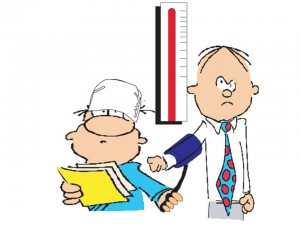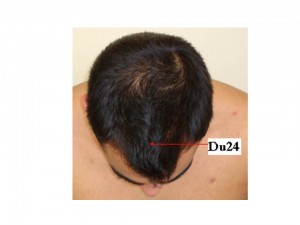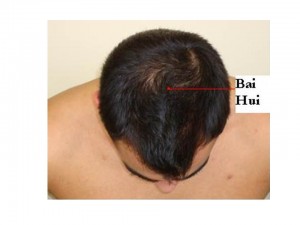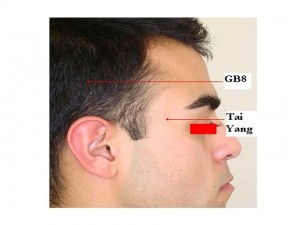News Letter, Vol. 4 (9), September , 2012, © Copyright
Jun Xu, M.D. Lic. Acup., Hong Su, C.M.D., Lic. Acup.
Robert Blizzard III, DPT
Rehabilitation Medicine and Acupuncture Center
1171 East Putnam Avenue, Building 1, 2nd Floor
Greenwich, CT 06878
Tel: (203) 637-7720
Fax: (203)637-2693
Hypertension
Hypertension
William S., a sixty-two-year-old man, works as a stock analyst. His day begins at 6AM and finishes at 7PM. His lifestyle is very stressful, but he is a regular exerciser, running five miles on Saturday and Sunday. He has no health problems, save that he smokes about half a pack of cigarettes a day and has been drinking coffee for thirty years. One morning, on awakening, he felt a sudden onset of weakness and numbness on the left side of his face and arm, as well as in his left leg, and he had a moderate headache. He had difficulty walking and called his wife who noted his speech was slurred. She called an ambulance and he was rushed to the emergency room where his blood pressure was found to be 160/100. A CT scan showed blood in his brain, so William was diagnosed with a hypertensive hemorrhagic stroke. He had emergency open-scalp surgery and the blood clot was removed from his brain, but after the surgery he felt the left side of his face drooping and there was weakness in his left arm and leg.
After three months of intensive physical therapy, his symptoms improved, but he asked his doctor how, considering that he eats right and exercises, he could have suffered a stroke. He did mention to the doctor that he had not been checked for hypertension for five years, though he and his wife had availed themselves of the free blood-pressure monitor at their local supermarket.
The doctor put him on two different antihypertensive medications and told him he needed to have his blood pressure checked yearly by his physician. For a correct blood pressure reading, the doctor advised him that the readings should be taken three times, at least a week apart, and then the numbers should be averaged.
Hypertension—a Leading Cause of Strokes
Hypertension is high blood pressure and it is one of the main causes of a stroke. A person can have high blood pressure for years without knowing it because high blood pressure usually has no symptoms, though occasionally headaches may occur. During this asymptomatic period, hypertension can do damage to multiple organs, such as the heart, the blood vessels, the kidneys, or the brain. For this reason, it is referred to as a silent killer because suddenly one day the hypertensive person has a stroke, or develops coronary heart disease, i.e. heart attack or kidney failure.
The following comprise the rule of thumb on how to accurately and effectively take blood pressure.
- Blood pressure should be taken at least one hour after caffeine, thirty minutes after smoking or strenuous exercise, and without any stress present.
- The person should be upright in a chair with both feet flat on the floor for a minimum of five minutes prior to taking a reading.
- Some people feel nervous on seeing doctors, a fairly common phenomenon known as white coat syndrome. To avoid this, the person getting the reading should be in a relaxed situation in an isolated room. Also, to counteract any discrepancy and assure an accurate result, three blood pressure readings should be taken at least five minutes apart and the results should then be averaged.
- Older people who are suspected of having orthostatic hypotension should be given initial measurements in both arms. And in order to obtain the correct blood pressure readings, this should be done in lying, sitting, and standing blood positions.
Definition of Hypertension (HTN)
Based on the U.S. National Heart, Lung, and Blood Institute 2003 guidelines, blood pressure is defined as follows.
- For adults age eighteen and above, normal systolic blood pressure is less than 120 mmHg, and diastolic blood pressure is less than 80 mmHg.
- Pre-hypertension systolic is 120–139, with diastolic is between 80–89.
- Stage 1 hypertension is between 140–159 systolic, with diastolic between 90 and more than 99.
- Stage 2 hypertension is more than 160 systolic, with diastolic more than 100.
Table 9.1
Classification of Blood Pressure (BP) for Adults:
| BP Classification | Systolic BP mmHg | Diastolic BP mmHg | Lifestyle Modification |
| Normal | <120 | <80 | Encourage |
| Prehypertension | 120–139 | 80–89 | Yes |
| Stage 1 HTN | 140–159 | 90–99 | Yes |
| Stage 2 HTN | > or = 160 | > or = 100 | Yes |
Sources: 7th Report of the Joint National Committee on the Prevention, Detection, Evaluation, and Treatment of High Blood Pressure (JNC 7), 2003
The Two Major Forms of Hypertension
Essential or Primary Hypertension
Ninety-five percent of those with hypertension exhibit essential or primary symptoms. Essential hypertension indicates that either no specific medical cause can be found to explain the person’s condition or that it might be caused by multiple factors. Those combined effects are responsible for HTN in approximately 72 million Americans.
Secondary Hypertension
This accounts for 5 percent of those with hypertension. In this instance, the high blood pressure is secondary to a specific abnormality, as for example kidney disease or tumors, adrenal adenoma, or other endocrine tumors.
Identifiable Causes of Hypertension
- Sleep apnea
- Drug induced (or related) causes
- Chronic kidney diseases
- Primary aldosteronism (adrenal gland overproduction of the hormone aldosterone)
- Renovascular disease
- Chronic steroid treatment
- Cushing’s syndrome (hormone disorder caused by high level of cortisol in blood)
- Adrenal gland tumor (pheochromocytoma)
- Narrowing (coarctation) of the aorta
- Thyroid or parathyroid disease
How Western Medicine Investigates Newly Diagnosed Hypertension
A physician will try to identify possible causes of secondary hypertension and seek evidence of end-organ damage to the heart, eyes, or kidneys.
Damages to Target Organs—Heart
- Muscle thickening (hypertrophy) in left ventricle, the heart’s main pumping chamber
- Angina or prior myocardial infarction
- Heart failure
Damages to Other Target Organs
- The brain: A stroke or a transient ischemic attack
- The kidneys: Chronic kidney disease
- The arteries: Peripheral artery disease
- The eyes: Damage to the retina of the eye (retinopathy)
Main Blood Tests Performed to Determine Causes and Results of HTN
Renal function. Creatinine test to identify any underlying renal disease as a cause of hypertension, as well as it causing the onset of kidney damage. In the meantime, a baseline needs to be set up to monitor the possible side effects of certain antihypertensive drugs on the kidneys.
Electrolytes, including sodium, potassium, calcium, chloride.
Glucose to identify diabetes mellitus.
Cholesterol to identify the possible cause of coronary artery disease.
Urine samples. A healthcare provider might take urine samples to check for proteinuria in order to find out if there is any underlying kidney disease or evidence of hypertensive renal damage.
EKG for evidence of any damage to the heart.
Chest x-ray to check for signs of cardiac enlargement.
A recent survey found that 30 percent of those with hypertension were not aware they had it; 41 percent did not receive any antihypertensive treatment; and only 34 percent of those surveyed had it under proper control.
Prevention of Hypertension
Prevention of damage related to high blood pressure is the most important issue, and lowering blood pressure to prevent end-organ damage to the retina, kidney, heart, or brain is crucial. The following prevention procedures are recommended by National Institute of Health and W.H.O.
- Weight reduction and regular aerobic exercise, such as walking, running, swimming, or bicycling. Several studies indicated that lower-intensity exercise may be more effective in lowering blood pressure than higher-intensity exercise.
- Reducing sodium in the diet decreases blood pressure in about 33 percent of people.
- Reducing sugar intake also helps.
- Quitting smoking and decreasing alcohol consumption to a minimum.
- Adopting the DASH (Dietary Approaches to Stop Hypertension) eating plan, which is rich in potassium and calcium, with reduced dietary sodium.
Lifestyle Modifications
Modifying lifestyles can reduce blood pressure, enhance antihypertensive efficacy, and decrease cardiovascular risk. As an example, a 1600 mg sodium eating plan has effects similar to single drug therapy. Combinations of two or more lifestyle modifications can achieve even better results.
Table 9.2
The Benefits of Lifestyle Modifications in Managing Hypertension
| Modification | Recommendation | Benefits |
| Weight reduction | Maintain normal body weight (mass index 18.5–24.9) | If you can lose 10 Kg, you may be able to lower your blood pressure about 5–20 mmHg |
| Adopt DASH eating plan | Consume a diet rich in fruits, vegetables, and low-fat dairy products with a reduced content of saturated and total fat | If you adopt this plan, you may be able to lower your blood pressure about 8–14 mmHg |
| Dietary sodium reduction | Reduce dietary sodium intake to no more than 100 mmol per day (2.4g sodium or 6g sodium chloride) | If you adopt this modification in your diet, you may be able to lower your blood pressure about 4–9 mmHg |
| Physical activity | Engage in regular aerobic physical activity, such as brisk walking at least thirty minutes per day most days of the week | If you adopt this plan, you may be able to lower your blood pressure about 2–4 mmHg |
| Moderation of alcohol consumption | Limit consumption to no more than 2 drinks (1 oz or 30 ml ethanol, 24 oz beer, 10 oz wine, or 3 oz 80 proof whiskey) per day in most men, and to no more than 1 drink per day in women and lighter weight people | If you adopt this modification, you may be able to lower your blood pressure about 2–4 mmHg |
Sources: 7th Report of the Joint National Committee on the Prevention,Detection, Evaluation, and Treatment of High Blood Pressure (JNC 7), 2003
Pharmaceutical Treatment of Hypertension
There are many people who are currently using pharmaceutical drugs, such as angiotensin-converting enzyme inhibitors (ACE inhibitors), angiotensin receptor blockers (ARBs), beta-blockers, calcium channel blockers, and thiazide type diuretics.
Diuretics of the thiazide type have been the basis of antihypertensive therapy in most outcome trials. In many studies, a diuretic works much better than other antihypertensive medications. Therefore, in the United States, the thiazide-type diuretic is the first choice to treat hypertension.
Table 9.3
Commonly Used Drugs
| Class | Name (Trade Name) | Usual dose range in mg/day | Usual Daily Frequency |
| Thiazide diuretics | Chlorothiazide (Diuril) | 125–500 | 1–2 |
| Loop diuretics | Furosemide (Lasix) | 20–80 | 2 |
| Potassium-sparing diuretics | Amiloride (Midamor)Triamterene (Dyrenium) | 5–1050–100 | 1–21–2 |
| Aldosterone receptor blockers | Spironolactone (Aldactone) | 25–50 | 1 |
| Angiotensin converting enzyme inhibitors | Lisinopril (Prinivil, Zestril†)Quinapril (Accupril) | 10–4010–80 | 11 |
| Angiotensin II antagonists | Irbesartan (Avapro)Losartan (Cozaar) | 150–30025–100 | 11–2 |
| Beta-blockers | Atenolol (Tenormin) | 25–00 | 1 |
| Calcium channel blockers—Dihydropyridines | Amlodipine (Norvasc) | 2.5–10 | 1 |
| Calcium channel blockers—non-Dihydropyridines | Diltiazem extended release | 180–420 | 1 |
Sources: 7th Report of the Joint National Committee on the Prevention, Detection, Evaluation, and Treatment of High Blood Pressure (JNC 7), 2003.
Thiazide-type diuretics should be used alone or in combination with one of the other classes, such ACE inhibitors, angiotensin receptor blockers, beta-blockers, or calcium channel blockers.
The Goal of Antihypertensive Therapy
The ultimate public health goal of antihypertensive therapy is the reduction of high blood pressure and cardiovascular disease. The aim of treatment for most people should be getting blood pressure readings to <140/90 mmHg, and even lower in certain contexts, such as diabetes or kidney disease (some medical professionals recommend keeping levels below 120/80 mmHg).
Achieving Blood-Pressure Control
Most people who are hypertensive will require two or more antihypertensive medications to achieve their blood-pressure goals. An additional second drug from a different class should be initiated when the use of a single drug in inadequate doses fails to achieve the blood-pressure goal. When the blood pressure is more than 20/10 mmHg above the goal, consideration should be given to initiate therapy with two drugs, either as separate prescriptions or in fixed dose combinations. However, the likelihood of a dramatic decline in blood pressure leading to dizziness when people attempt to stand (orthostatic hypotension), must be mentioned, as it can occur in people who have diabetes, or in older people and there could be a dysfunction of the autonomic nervous system that regulates unconscious body functions, including blood pressure and heart rates.
Treatment for Hypertension in Traditional Chinese Medicine—Acupuncture
There is a thousand year history of acupuncture treatment for different symptoms of hypertension, but there is no word in Chinese history for hypertension. The hypertension diagnosis is always found where there are symptoms of dizziness, faintness, strokes, and headaches. In recent studies, it was shown that acupuncture treatment can be an excellent adjunct to medical treatment, especially for those who are diagnosed with prehypertension or stage 1 hypertension, even stage 2 hypertension. In these instances, acupuncture might greatly decrease the dosage of antihypertensive medications, and also decrease the side effects of these medications. I do not, however, recommend discontinuing antihypertensive medications and using acupuncture as the only treatment.
In traditional Chinese medicine, hypertension is manifested as following two types.
Excessive Liver Yang
The person usually shows dizziness, tinnitus, and headaches, sometimes emotional upset, anger, facial redness, insomnia, and vivid dreams or nightmares. The treatment should be focused on lowering the excessive liver yang.
- The points should be liver UB 18 Gan Shu, Liv 3 Tai Chong, Xia Xi, UB 23 Shen Shu, GB 20 Feng Qi, Li 4 He Gu, and Li 11 Qu Qi.
- Sp 6 San Yin Jiao, PC 6 Nei Guan, and Zu Ling Qi are sometimes added.
Table 9.4
| Points | Meridian Number | Conditions Helped | |
| 1 | Gan Shu | UB 18 | Backache, blurred vision, epilepsy, jaundice, mental disorders, night blindness, redness of the eye, spitting blood |
| 2 | Tai Chong | Liv 3 | Headaches, dizziness and vertigo, insomnia, congestion, swelling and pain of the eye, depression, uterine bleeding, retention of urine, epilepsy |
| 3 | Xia Xi | GB 43 | Headaches, dizziness and vertigo, tinnitus, deafness, swelling of the cheek, pain in the breast, fever |
| 4 | Shen Shu | UB 23 | Asthma, blurred vision, deafness, diarrhea, dizziness, swelling, impotence, irregular menstruation, low back pain, nocturnal emissions, tinnitus, weakness of the knee |
| 5 | Feng Chi | Gallbladder 20 | Headaches, vertigo, insomnia, pain and stiffness of the neck, blurred vision, glaucoma, red and painful eyes, tinnitus, convulsion, epilepsy, infantile convulsions, common cold, nasal obstruction |
| 6 | He Gu | Li 4 | |
| 7 | Qu Chi | Li 11 | |
| 8 | San Yin Jiao | Sp 6 | |
| 9 | Nei Guan | PC 6 | |
| 10 | Zu Ling Qi | GB 41 | Headaches, vertigo, pain in the breast, irregular menstruation, pain and swelling of the back of the foot, spastic pain of the foot and toe |
Please refer to the accompanying Figures (illustrations) for the locations of
the points. And please note that these illustrations are for information only
and may not show all the exact locations of the acupuncture points.
Figure 9.1
Deficiency of Blood and Qi (Energy)
The person very often feels dizziness and faintness; the dizziness is triggered by fatigue and always becomes worse when getting up from a sitting position. This deficiency is always accompanied by a pale face, and sometimes heart palpitations, insomnia, fatigue, slowed speech, and poor appetite. The treatment for this condition should be focused on nourishing the qi and blood and improving the function of the spleen and stomach. The acupuncture points for this are the following.
- UB 20 Pi Shu, St 36 Zu San Li, Du 20 Bai Hui, Ren 6 Qi Hai, Li 3 Zhang Men, Shen Ting and Li 4 He Gu.
- For an acute hypertensive crisis, Extra Point Tai Yang, Du 20 Bai Hui, and St 40 Fen Long can be used.
- Some studies show that by piercing extra points of Tai Yang and Yin Tang with slight bleeding the blood pressure will usually drop quickly.
- If there is a severe headache in the forehead, UB 2 Zan Zhu is used.
- If the headache is on the top of scalp, Du 20 Bai Hui and Extra Point Si Shen Chong are added.
- If there is neck pain with stiffness, GB 20 Feng Qi is used.
- If there is dizziness accompanied with tinnitus, St 8 Tou Wei is also added.
Table 9.5
| Points | Meridian Number | Conditions Helped | |
| 1 | Pi Shu | UB 20 | |
| 2 | Zu San Li | St 36 | |
| 3 | Bai Hui | Du 20 | |
| 4 | Qi Hai | Ren 6 | |
| 5 | Zhang Men | Li 3 | |
| 6 | Shen Ting | Du 24 | Anxiety, epilepsy, headache, insomnia, palpitations, runny nose, vertigo |
| 7 | Feng Long | St 40 | |
| 8 | Tai Yang | Extra Point | Headaches, eye diseases, deviation of the eyes and mouth |
| 9 | Yin Tang | Extra Point | |
| 10 | Zan Zhu | UB 2 | |
| 11 | Si Shen Chong | Extra–HN 1 | |
| 12 | Feng Chi | GB 20 | |
| 13 | Tou Wei | St 8 |
Please refer to the accompanying Figures (illustrations) for the locations
of the points. And please note that these illustrations are for information
only and may not show all the exact locations of the acupuncture points.
Figure 9.2
Fig 9.3
Fig 9.4
Treatment for William
William was diagnosed with excessive liver yang and underwent my treatment. After three months, his blood pressure became stable and under control, and only minimum dosages of the antihypertensive drugs were used.
Hypertentsion Tips for Use at Home or Office
- Be calm and relaxed. Do not add stress on top of your blood pressure.
- Massaging Tai Yang and Bai Hui will usually help you decrease your headache and your blood pressure. Acupressure the points with your thumb or knuckle, pressing with comfortable pressure on the points; count to 20, then change to another point.
- After the blood pressure comes down, maintenance with acupuncture is necessary once a week in the short term, and is also very useful and effective in the long run.





